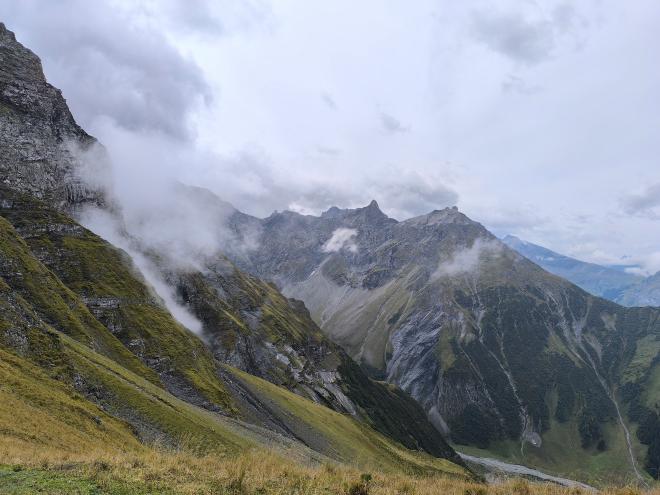The Path to the Pass

It was still quite early, and I started the day full of expectations. A hike over a pass between two valleys, somewhere between two seasons: summer and autumn. The first fallen leaves had already changed color.
After a few hundred meters of ascent, a marmot pulled me from my thoughts with its sharp whistles. It was already nice and round, slowly getting ready for its long hibernation. Otherwise, not a soul to be seen, only the ding-dong of cowbells to be heard, until I reached the farm located furthest back in the valley.
After that, things started to get serious. The path snaked its way up, and a brisk wind blew, accompanied by cool temperatures. After a while of exertion, I avoided looking up. To see how much further I had to go to the pass? The sight might have discouraged me from continuing. I wanted to avoid that at all costs.
There was still not a soul in sight. Otherwise, I would have automatically compared my pace with others, my performance with theirs. That would have led nowhere. You shouldn’t compare yourself to anyone. Because each of us has a different path or different experiences, a comparison isn’t necessarily meaningful. I can only compare myself with my former self and see if I’ve become better or worse, or how I’ve changed. That’s how I see how I should plan my next steps.
Having soon conquered the last hill, I marched past a small hut where flocks of sheep roam in the summer.
Then came the final slope. In the summer, it always demands many beads of sweat. Just don’t stop now! One step after another, first with the left foot, then with the right foot. And so on. Until the pass was reached.
Just last week, I learned how this works. The things I do change how my brain thinks about them. So, when I do things, and because I do them, I think about them differently afterward. Where I used to think something was impossible and didn’t even try, it’s different now. I just do these things to prove to my brain that it is possible. Even if you have to force yourself to do it. Then, after repeatedly pushing yourself, the brain learns that these things are possible.
As I saw today, this strategy — to keep moving — paid off. The brain saw that I was in motion. Even if I’m only taking tiny steps sometimes. But I’m staying in motion. In the end, that’s what counts.
After the pass, I had to descend briefly to another mountain pasture before the final crossing. The clouds grew denser, but it stayed dry. On the way down, a few cows followed me curiously. These are their last days before the Alpabtrieb (the seasonal descent of cattle from the mountain pastures).
I wondered, why do you have to go down from one peak to be able to climb the next one? Can I compare this to a career? Does a setback have to happen in order for you to grow? Probably not always. Even though you best learn from your own mistakes.
It’s different with mountain peaks. You make progress by climbing enough peaks and getting back down safely each time. It’s about training. It’s about improving each time. It’s about proving to your brain that it’s possible.
My conclusion from today is that I can actively push myself to do things until I finally believe in them and don’t give up.